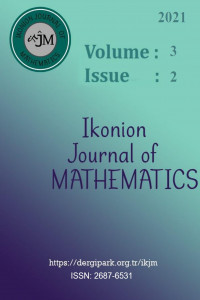Öz
In the historical development of Riesz spaces, we can trace the history of ordered vector spaces to the International Mathematical Congress in Bologna in 1928. Studies related with f-Algebras for the Dedekind complete ordered vector space defined in Riesz spaces were initiated by Nakano and their current definition was made by Amemiya, Birkhoff and Pierce.The revival of f-algebras, which had a tendency to slow down for a period of time, emerged as a result of Pagter's doctoral thesis [9] and the examination of Alkansas lecture notes by Luxemburg.
The concepts of homomorphism, isomorphism, orthomorphism and biorthomorphism in Riesz spaces are defined by Zaanen, Huijsmans, Boulabiar, Buskes and Triki. Algebraic structure of biorthomorphisms defined on Riesz space examined by [8]. f-Algebra on Orth(X,X) were studied by [8] and [6]. [6] demonstrated that biorthomorphisms space have an f-algebraic structure with the help of the product defined as (T_1 *_e T_2)(x,y)=T_1 (x,T_2 (e,y)) for e∈X^+, ∀x,y∈X ve T_1,T_2∈Orth(X,X).
[8] showed that if orthomorphisms are semiprime Dedekind complete f-algebras, it is an ordered ideal in biorthomorphisms. [6] developed an alternative proof for this situation. If X Archimedean Riesz space, Orth(X) is an f-algebra according to compound operation with unit element.
[10] showed that if the orthomorphism X is a semi-prime f-algebra, it is a d-algebra. In this study, we investigated embedding orthomorphism in biorthomorphisms when X is uniformly complete d-algebra.
Anahtar Kelimeler
Kaynakça
- [1] Aliprantis, C. D., Burkinshaw, O. ( 2006) Pozitif Operators. Springer, Dardrecth.
- [2] Benamor, F . (2014) On Bi-orthomorphisms on a Semiprime f-Algebra. Indag. Math., 25: 44-48.
- [3] Bernau, S. J., Huijsmans, C. D. (1990) Almost f-Algebras and d-Algebras. Math. Proc. Cambridge Philos. Soc. 107: 287-308.
- [4] Birkhoff, G., Pierce, R.S. (1956) Lattice-ordered rings, An Acad. Brasil. Cienc. 28: 41-49.
- [5] Birkhoff, G. (1967) Lattice Theory. Amer. Math. Soc. Colloq. Publ., 25, Providence, RI. MR 37 2638.
- [6] Boulabiar, K., Brahmi, W. (2016) Multiplicative Structure of Biorthomorphisms and Embedding of Orthomorphisms. Indag. Mathem, 27(3): 786–798.
- [7] Buskes, G., Rooij, A. (2000) Almost f -Algebras: Structure and the Dedekind Completion. Positivity, 4: 233–243.
- [8] Buskes, G., Page, R. and Yilmaz, R. (2010) A note on bi-orthomorphisms. Oper. Theory Adv. Appl., 201: 99–10.
- [9] De Pagter, B. (1981) f- algebras and orthomorphisms. Phd. Thesis, University of Leidin.
- [10] Huijsmans, C.B. (1991) Lattice ordered algebras and f-algebras. A survey. Studies in Ekonomic Theory 2, Positive Operators, Riesz Spaces and Economics (C. D. Aliptantis, K. C. Border and W. A. J. LuAemburg, eds.) Spinger, Berlin, 151- 169.
- [11] Kudlacek, V. (1962) On some types of l-rings. Sborniysokehovceni Techn v Brne, 1-2: 179-181.
- [12] Kusraev, A. G., Tabuev, S. N. (2008) Multiplicative Representatıon of Bilinear Operators. Siberian Mathematical Journal, 49(2): 287-294.
- [13] Zaanen, A. C. (1975) Examples of othomorphism. J. Approximation theory, 13: 192-204.
Öz
Kaynakça
- [1] Aliprantis, C. D., Burkinshaw, O. ( 2006) Pozitif Operators. Springer, Dardrecth.
- [2] Benamor, F . (2014) On Bi-orthomorphisms on a Semiprime f-Algebra. Indag. Math., 25: 44-48.
- [3] Bernau, S. J., Huijsmans, C. D. (1990) Almost f-Algebras and d-Algebras. Math. Proc. Cambridge Philos. Soc. 107: 287-308.
- [4] Birkhoff, G., Pierce, R.S. (1956) Lattice-ordered rings, An Acad. Brasil. Cienc. 28: 41-49.
- [5] Birkhoff, G. (1967) Lattice Theory. Amer. Math. Soc. Colloq. Publ., 25, Providence, RI. MR 37 2638.
- [6] Boulabiar, K., Brahmi, W. (2016) Multiplicative Structure of Biorthomorphisms and Embedding of Orthomorphisms. Indag. Mathem, 27(3): 786–798.
- [7] Buskes, G., Rooij, A. (2000) Almost f -Algebras: Structure and the Dedekind Completion. Positivity, 4: 233–243.
- [8] Buskes, G., Page, R. and Yilmaz, R. (2010) A note on bi-orthomorphisms. Oper. Theory Adv. Appl., 201: 99–10.
- [9] De Pagter, B. (1981) f- algebras and orthomorphisms. Phd. Thesis, University of Leidin.
- [10] Huijsmans, C.B. (1991) Lattice ordered algebras and f-algebras. A survey. Studies in Ekonomic Theory 2, Positive Operators, Riesz Spaces and Economics (C. D. Aliptantis, K. C. Border and W. A. J. LuAemburg, eds.) Spinger, Berlin, 151- 169.
- [11] Kudlacek, V. (1962) On some types of l-rings. Sborniysokehovceni Techn v Brne, 1-2: 179-181.
- [12] Kusraev, A. G., Tabuev, S. N. (2008) Multiplicative Representatıon of Bilinear Operators. Siberian Mathematical Journal, 49(2): 287-294.
- [13] Zaanen, A. C. (1975) Examples of othomorphism. J. Approximation theory, 13: 192-204.
Ayrıntılar
| Birincil Dil | İngilizce |
|---|---|
| Konular | Matematik |
| Bölüm | Makaleler |
| Yazarlar | |
| Yayımlanma Tarihi | 10 Ekim 2021 |
| Kabul Tarihi | 20 Aralık 2021 |
| Yayımlandığı Sayı | Yıl 2021 Cilt: 3 Sayı: 2 |


